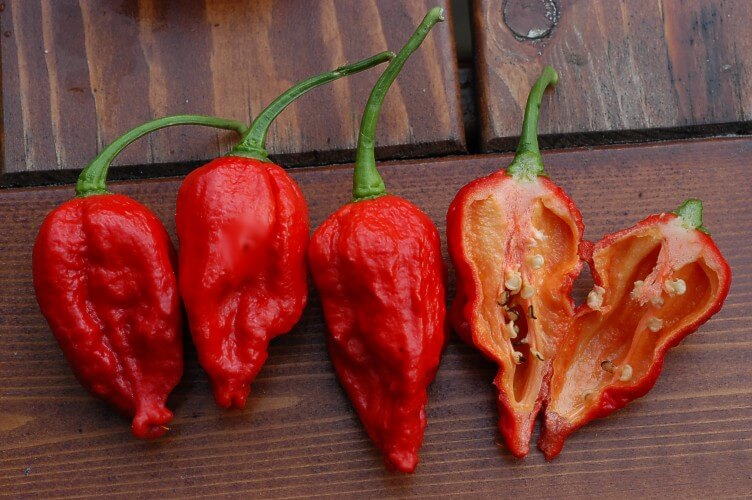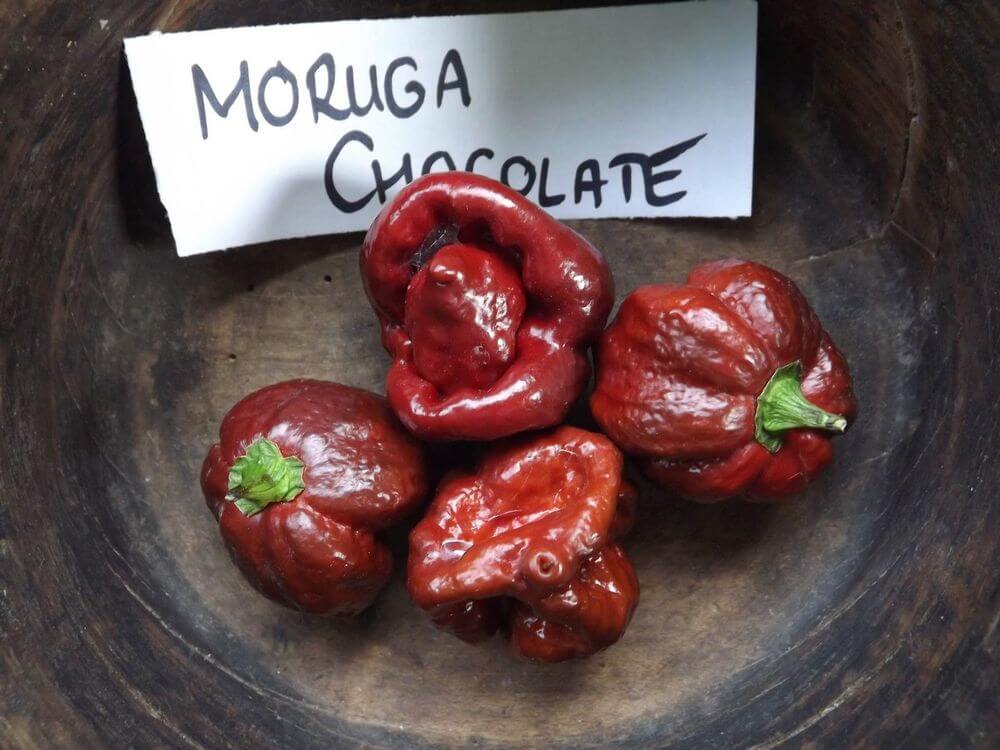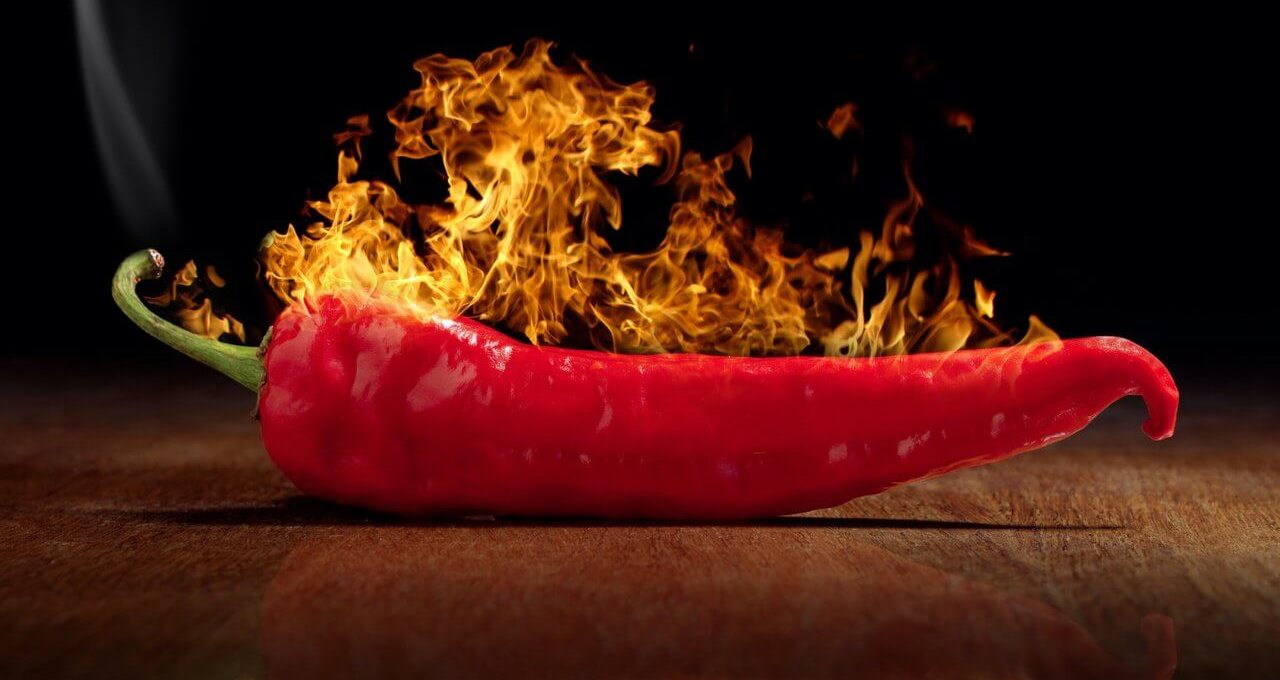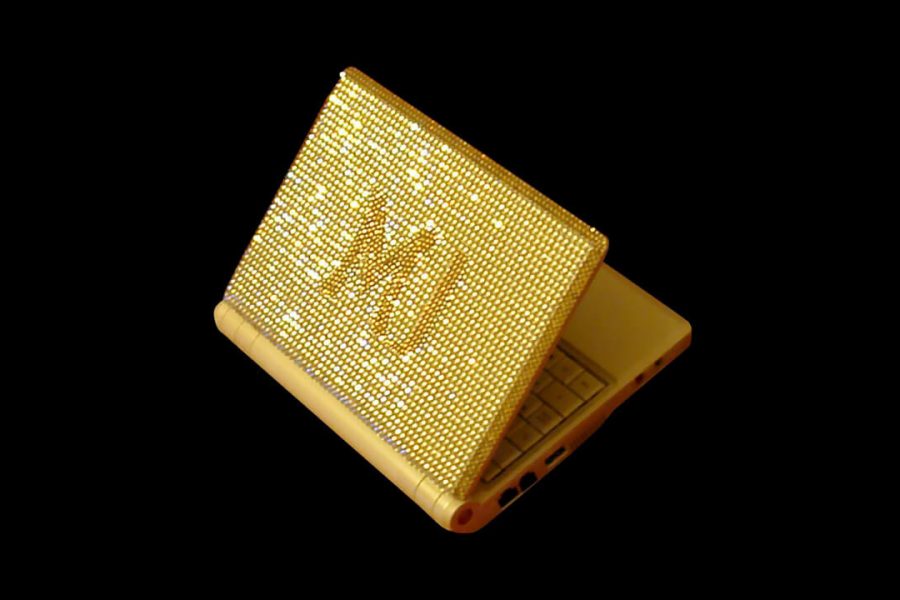The culture of cultivating the hottest pepper in the world is almost as ancient and no less complex than growing grapes for wine. There are many varieties - different shapes, tastes and, of course, degrees of spiciness. Some of them are so hot that dishes with them have to be prepared in special protective equipment.
It's amazing how anyone in their right mind would want to feel such a fire inside themselves. But there are fans, and there are plenty of them. The hottest varieties have long had their own fan clubs, the harvests are covered in the relevant press, and people are training their taste buds to feel the extra heat in order to enter select circles.
List of the hottest peppers
10. Naga Viper
 Scoville Heat Scale (SHU): 1,382 million
Scoville Heat Scale (SHU): 1,382 million
Comparison with jalapeno (medium chili pepper): 553 times hotter.
Country of origin: England.
What do you get when you cross three of the hottest peppers? Naga Viper! This plant with character has an impressive pedigree – its parents are Moruga Scorpion, Naga Morich, and the “ghost pepper” – a chilli variety that grows on the border of India and Bangladesh and is distinguished by its high capsaicin content and, accordingly, fiery taste.
The Naga Viper's heat is slow, meaning that the person who puts it in their mouth will first feel the fruity sweetness of the shell before the fiery mouth of hell opens up. About 7 years ago, in 2011, the Naga Viper was considered the hottest pepper in the world and was even included in the Guinness Book of Records, until a year later it was defeated by its own parent (which, by the way, occupies an honorable sixth place in this rating).
9. Naga Morich
 SHU: 1.5 million
SHU: 1.5 million
Comparison with Jalapeno: 600 times sharper.
Country of origin: India.
Indians know a thing or two about spices - like the "ghost pepper", Naga Morich comes from the southern regions of India. In general, Naga Morich tastes very similar to its "wild" brother - like it, the fiery nature of the modern variety is revealed slowly.
It takes about 30 seconds for a person to taste the flames. Before that, the taster only feels pleasant fruity notes. That's why this pepper is so good in sauces and marinades for kebabs - at first pleasant, soft and juicy, and then demonically hot. Surprisingly, Indians and Bengalis like to eat Naga Morich peppers whole, like a salad. However, they only risk doing this with green fruits that have not yet reached their true spiciness.
8. Dorset Naga
 SHU: 1,598 million
SHU: 1,598 million
Comparison with Jalapeno: 639 times sharper.
Country of origin: England.
There is some debate among pepper connoisseurs as to whether Naga Morich and Dorset Naga are the same variety. Technically, yes, but Dorset Naga is definitely the next evolutionary step of the variety. It was created in England by breeders who spent years carefully selecting seeds from only the hottest Naga Morich plants. However, Dorset Naga has become so popular around the world that its suspicious relationship to Naga Morich is now overlooked.
Dorset Naga's spiciness develops even more slowly than its older brother, and its delicate fruity notes are more pronounced, making it even better in marinades and sauces.
7. 7 Pot Douglah
 SHU: 1,854.
SHU: 1,854.
Comparison with Jalapeno: 742 times sharper.
Country of origin: Trinidad.
Without a doubt, this plant is one of the top ten hottest pepper varieties, but its appearance and taste are different from others. The skin of this pepper is chocolate-colored instead of the usual fire-red, and the taste is not only fruity, but even a little nutty. Therefore, 7 Pot Douglah is a unique phenomenon in its own way, both in appearance and taste. And in spiciness, too.
Peppers with a heat rating of 1.8 million or more should be handled with care. Just one drop of juice is enough to cause a serious skin burn, so when cooking with extra-hot varieties, you should wear gloves and even goggles. It's scary to imagine what would happen if the juice got on your cornea! A tiny amount is enough to add spice to food - it's not for nothing that this variety is called 7 Pots, which means "seven pots." That is, one such pepper is capable of igniting the contents of at least seven pots.
6. Trinidad Moruga Scorpion
 SHU: 2 million
SHU: 2 million
Comparison with Jalapeno: 800 times sharper.
Country of origin: Trinidad.
Calling the Trinidad Moruga Scorpion “hot” is like saying the surface of the sun is “hot.” That’s true, but it doesn’t capture the full scope of the phenomenon. The Trinidad Moruga Scorpion is a pepper so hot that people are forced to handle it like a nuclear warhead – gently, carefully, and in protective gear. It’s so hot that only five varieties worldwide are hotter, one of which is its own variety.
The spiciness of this pepper not only unfolds slowly, it also lasts a long time! At first, everything looks quite innocent, but after half a minute, fire spreads through a person’s veins, he sweats, hiccups, sneezes, his eyes begin to water… It is clear that most people never eat it raw under any circumstances. Therefore, Trinidad Moruga Scorpion is added to very hot sauces and seasonings, so that its spiciness is at least slightly diluted by more neutral ingredients.
5. Trinidad Scorpion Chocolate
 SHU: 2 million
SHU: 2 million
Comparison with Jalapeno: 800 times sharper.
Country of origin: Trinidad.
Although both the sixth and fifth place spiciness scales look the same, their flavors are noticeably different. The “chocolate” version is softer, juicier, riper, less acidic, with smoky notes and a hint of earthy sweetness.
But don't let that sweetness fool you - Trinidad Scorpion Chocolate has claws, and very sharp claws that dig deep into the stomach and linger for a very long time. They are even sharper than those of its "big brother" - the minimum values on the Scoville scale for the "chocolate" variety are higher.
4. Chocolate Bhutlan
 SHU: 2 million
SHU: 2 million
Comparison with Jalapeno: 800 times sharper.
Country of origin: USA.
Although the Chocolate Bhutlan has the same maximum value as the two Trinidad Scorpion varieties, its “lower” limit is higher. It is one of the “fast” peppers, whose demonic nature is felt immediately, like a kick from a hoof. Chocolate Bhutlan is a hybrid of two very hot peppers, Bhut Jolokia, a “ghost pepper”, and the seventh place in the rating, 7 Pot Douglah. Hence the name – Bhut-lah. The taste of this pepper, like other “chocolate” varieties, is sweet, earthy, and the smell is floral.
3. Komodo Dragon Pepper
 SHU: 1.4 – 2.2 million
SHU: 1.4 – 2.2 million
Comparison with Jalapeno: 880 times sharper.
Country of origin: England.
Without a doubt, only true fans are capable of eating this pepper. Like the "ghost pepper", it opens up slowly, first allowing you to fully experience its sweet fruity tones.
Unlike other super-hot varieties, which are only available to dedicated fans who order them by mail or buy them in specialty shops, Komodo Dragon Pepper can be bought in any UK supermarket. Yes, it’s just sitting there on the shelf, a pepper that rivals the famous Carolina Reaper in its heat.
It's impossible to eat this pepper without diluting it with something (and more). Like its distant relative, the "Seven Pots," one Komodo Dragon pepper is enough to add fire to many dishes.
2. Carolina Reaper
 SHU: 2.2 million
SHU: 2.2 million
Comparison with Jalapeno: 880 times sharper.
Country of origin: USA.
When the Trinidad Moruga Scoprion took the title of the hottest pepper in the world from its brainchild in 2012, did its creators know that the end was near? In secret US laboratories, its replacement was already maturing – the Carolina Reaper, which entered the Guinness Book of Records in 2013. The creator of this tame dragon is Ed Curry, the owner of the Puckerbutt Pepper Company, located, naturally, in South Carolina. The Carolina Reaper is the fruit of love between a subspecies of red habanero and the Naga Viper pepper, which is ranked tenth. As Ed himself said, he just wanted to create a sweet pepper that would be a little hotter. Well, he succeeded.
Interestingly, Ed began growing peppers for health reasons, as he had a history of cancer in his family, and the healing properties of hot peppers caught his attention. His hobby grew into a passion, and his passion became a way to earn a living.
1. Dragon's Breath - the hottest pepper in the world
 SHU: 2.480 million
SHU: 2.480 million
Comparison with Jalapeno: 992 times sharper.
Country of origin: England.
In the war between the USA and England for the right to be called the birthplace of the hottest pepper in the world, England seems to be winning. One of the latest hot varieties bred in foggy Albion has the telling name "Dragon's Breath". It got its name in honor of the national coat of arms of Wales, which depicts this mythical beast. Compared to "Reaper", the peak power of "Breath" is 280 units higher, which is equal to as many as 12 jalapeno peppers!
Obviously, such thermonuclear pepper is not intended for mass consumption. On the contrary, it was created to replace painkillers for those who are allergic to conventional medical anesthetics.
However, the question of which pepper is the hottest has not yet been resolved. The US is not going to give up. Recently, information came from the Carolina laboratory that the creator of the "Reaper" is not going to rest on his laurels. The new pepper in his collection, so far called Pepper X, or "Pepper X", breaks all records - they say that its power is equal to 3.18 million Scoville units!
Hot Pepper Eating Competition
For some people, even a moderately hot chili pepper can turn a stew into a cauldron of lava. And for others, only a large amount of pepper can give food flavor. However, there is a third category - those who seek out the hottest peppers and eat them at competitions. For such people, there is even a special term, "pyrogourmaniac", where pepper is responsible for "pyro", "gourmet" - for taste sensations, and "maniac" adequately reflects their mental characteristics.
These people with questionable common sense willingly subject themselves to torture with extra-hot varieties of red pepper, challenging both their willpower and the mucous membrane of the stomach. Warning! If you even consider the jalapeno pepper on pizza hot, then you should watch this video with a glass of milk.
But fun can turn into trouble, as one participant in one of these competitions recently experienced. After eating a particularly hot variety of "Carolina Reaper," he experienced a severe headache. The hot pepper caused a narrowing of the blood vessels in the brain, taking revenge on its eater.
Scoville heat scale
We all know that hot peppers really do burn your tongue, but how much? The answer to this question is provided by a special scale of hotness (no other unit of measurement in the world has ever been so hot). Peppers are ranked on it from “spicy” to “Oh, no! I’m going to catch fire! And the furniture I’m sitting on, too!”
It was invented by Wilbur Scoville, who, surprisingly, worked not as a chef, but as a pharmaceutical specialist.
- He came up with a very simple way to measure the hotness of a pepper based on a person's ability to perceive hot taste.
- The units of measurement are parts of water with sugar, which must be added to the same part of chili pepper, so that the taster does not feel any heat in the mouth at all.
- For example, one part of crushed poblano pepper would require approximately 1,500 parts of water for a person to not notice its presence in the solution at all.
But science does not stand still: scientists have come up with a high-tech analogue of Scoville's original method. They use liquid chromatography to measure the amount of capsaicin in chili peppers, which is responsible for the hot taste.
However, despite all the chemical tests in the world, the hotness of peppers remains a subjective concept. The degree of responsiveness of taste buds in the mouth is individual for each person, and if one can absorb fire-breathing peppers by the kilogram, then another feels a pain in the stomach from the sight of a red pod. Plus, like grapes, the taste of pepper varies depending on the country where it is grown, the composition of the soil, the number of sunny days per year and many other nuances. The hotness of neighboring pods on the bush can also differ significantly!














Оставить Комментарий